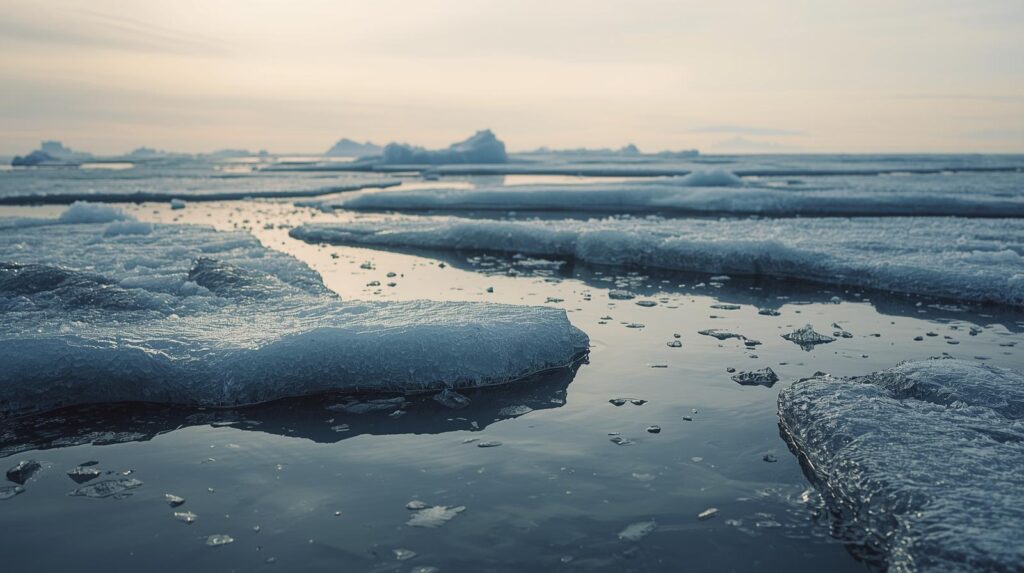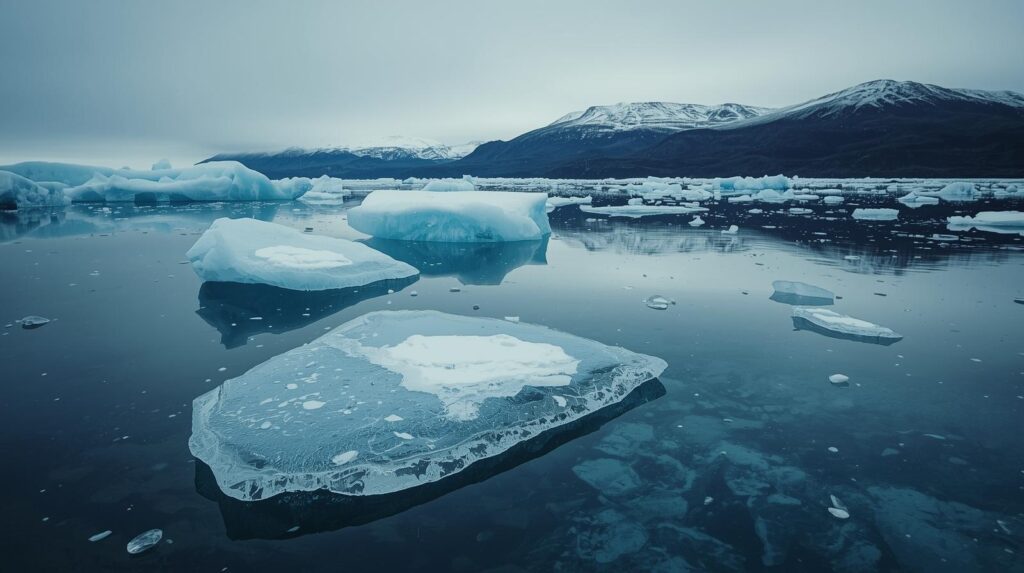What do you think about fast melting ice? Imagine being on your go-to beach with waves licking at your toes. Now envision that beach underwater within a few decades. Or consider a mountain farmer relying on a glacier to irrigate crops, only to see the river dry up. It isn’t a Hollywood film—but what’s going on as the ice on Earth melts more rapidly than it ever has before. From the Arctic to Antarctica to glacial mountains, the ice is melting due to human activities such as the burning of coal, oil, and gas. This ice melting is altering our planet’s future, changing where we live, what we consume, and how we survive. Let us deconstruct it in easy language and see what’s on the line.
What’s Happening to the fast melting Ice?
Earth’s ice exists in three forms: sea ice floating on seas (such as in the Arctic), massive ice cover on land (such as in Greenland and Antarctica), and glaciers in mountains. These have existed for thousands of years, maintaining the Earth’s temperature constant. Ice reflects sunlight, which makes it colder. However, humans are warming the Earth by letting out gases from vehicles, factories, and cutting down trees. This warm air is melting ice at a rate faster than it can replenish itself.

Ice is melting in the Arctic. In March 2025, scientists stated the ice reached its annual maximum earlier than normal, an indication something is wrong. The Arctic may have no summer ice by the end of this century. Ice shelves are collapsing, and land ice is melting rapidly in Antarctica. A 2025 study cautioned Antarctica ice to lead to a significant sea level rise. Mountain glaciers are also disappearing. One report this year revealed glaciers lost 5% of their ice in only 20 years—the quickest ever. Even the United Nations made 2025 the Year of Glacier Protection to sound the alarm.
Rising Seas, Sinking Cities
The largest concern due to melting ice is the increase in oceans. When ice sheets and glaciers melt, water enters the ocean. Warm water also expands. Currently, seas are rising roughly an eighth of an inch every year, but it’s accelerating. By 2100, we may experience one to six feet of rise, depending on our actions.
This is not good for coastal regions. Towns like Miami, New York, or Mumbai are already getting flooded on sunny days because tides are higher. In countries like Bangladesh or tiny Pacific islands, entire towns might vanish. More than 40% of the population lives close to coasts—that’s billions in danger. Houses, roads, and fields might be destroyed by saltwater. Storms such as hurricanes will strike more strongly with no ice to hold them up. The U.S. Gulf Coast might lose trillions of dollars. The poorest nations will be hit hardest, and millions may need to relocate, becoming climate refugees.
Zany Weather Shifts
Melting ice doesn’t only increase seas—it disrupts weather. Ocean currents, such as the one warming Europe, rely on cold water from melting ice. As the fresh water swamps in, the currents might slow and cool Europe or dry out the Amazon. In 2025, a study indicated Arctic ice melting would intensify heatwaves in regions such as the U.S. and Europe. Picture 100-degree summers as the norm, or droughts that strike California more severely. Asian or African farmers who require frequent rains might lose crops, leading to food shortages. It’s a domino effect: melt the ice, and weather gets out of hand.
Animals in Trouble
Even wildlife is suffering. Polar bears require Arctic sea ice to hunt seals. Without it, they’re hungry or swimming too far. Penguins in Antarctica lose their house when ice breaks up. Mountain species such as snow leopards experience decreasing territory as glaciers melt. A report issued in May 2025 stated glacier melting will erase many species. Fish in rivers fed by glaciers may do well for a while, but when water runs out, they’re in trouble. Coral reefs, already under stress from warm oceans, take harder blows from shifting water. Ecosystems are threatened entirely due to our actions.
Water and Food in Peril
Glaciers supply rivers that millions use for drinking and agriculture. In regions such as the Himalayas, referred to as the “Third Pole,” melting is sinking more water today, but in the future those rivers may dwindle. Villages in Peru or Pakistan already experience longer dry seasons. By 2050, 250 million individuals living in mountains may run out of water. That equals less food, more expensive food, and battles for what remains. In the Arctic, fishing is expanding as ice melts, but warmer oceans may collapse fish stocks later, damaging fishermen.
Money and Power Struggles
Warming ice is transforming economics and politics as well. Shorter routes through newly opened Arctic shipping lanes cut shipping time in half between Europe and Asia. Countries like Russia want oil and gas under the ice, causing arguments over who owns what. But the costs are huge—flooded cities need expensive fixes, coastal homes are harder to insure, and tourism in icy places like Alaska is changing. A 2025 report stated sea level rise would cost trillions and move 200 million by 2050. Countries are also competing for Arctic territory as ice melts, and others even place troops there. Water scarcity may ignite wars in South Asia if glaciers continue to shrink.
Countries Where Glaciers Are Melting Quickly
Globally, glaciers are melting faster than ever due to climate change, and it’s affecting most countries severely. Glaciers keep fresh water, but when they decrease, it leads to flooding, water scarcity, and huge issues for those people who live close by. Let’s have a look at some major countries that are suffering from this, such as Pakistan, where the impact is extremely challenging at present.
In the United States, particularly in Alaska and the Rockies, glaciers such as those found in Glacier National Park are melting rapidly. Scientists predict the park may have no glaciers by 2030. That would mean less water for rivers that run farms and cities in the West, and an increased risk of wildfires as the ground dries faster. Those in cities such as Denver or Seattle may notice warmer, drier summers.
Up north in Canada, the rocks and the distant north glaciers are melting as well. The Athabasca Glacier, a major tourist attraction, has lost more than a mile since the 1800s. That impacts water for millions of people in cities such as Calgary and Vancouver, and it devastates the salmon runs that First Nations people rely on as a source of food. And melting permafrost is sinking roads and buildings.
Europe has its own problems. In the Alps and Switzerland, glaciers such as the Aletsch are melting at record rates—nearly 5% per annum recently. This puts ski resorts and the Rhine River water supply at risk, which serves half of Europe. Austria, Italy, and France are constructing walls to contain floodwater from unexpected melts, but in the long run, rivers might dry up during summer, affecting farmers and power plants.
Across the Himalayas, the “Third Pole,” it’s not good for India, Nepal, Bhutan, and China. They all share thousands of glaciers that supply rivers such as the Ganges and Yangtze, sustaining more than a billion people. In Nepal, melting has brought catastrophic floods to the Everest area, destroying villages. India fears drying up of the Indus and Brahmaputra, which may lead to wars over water with neighbors. China also sees the same happening in Tibet, where glaciers supply the Mekong.

Now, one of the worst-affected areas is Pakistan. It has more glaciers beyond the poles anywhere—more than 7,000 in the Hindu Kush and Karakoram mountains. But they’re melting really quickly, leading to massive GLOFs (glacial lake outburst floods). Last year, a major one in Gilgit-Baltistan destroyed bridges, homes, and crops, and killed dozens. The Indus River, 220 million people’s lifeline in Pakistan, derives its water primarily from these glaciers. Currently, melting provides additional flow, but shortly, it will fall, resulting in droughts that might reduce farm production by 30%. Lahore and Karachi already experience water shortages, and scientists predict famines or migration if action is not taken. Pakistan’s government is attempting to keep an eye on with satellites, but it’s difficult with that many poor people depending on the land.
In South America, Bolivia and Peru are struggling in the Andes. Glaciers in Peru’s Cordillera Blanca lost 50% of their ice since the 1970s, with lakes bursting and flooding valleys. The cities of Lima, which receive 80% of water from glaciers, may dry up. Bolivia’s Chacaltaya glacier is nearly extinct, impacting tourism and herding communities.
Even on distant islands such as New Zealand, the glaciers of the Southern Alps are pulling back, influencing hydropower and rivers. And on Iceland, south of the Arctic Circle, Vatnajökull is melting, modifying the entire island’s climate and causing flooding.
These nations demonstrate the way glacier melt isn’t simply a cold issue—it’s worldwide. From floods in Pakistan to dry faucets in California, it’s redefining lives. We must reduce emissions and assist these nations in adapting, or the problems will intensify all around.
What Is the Future?
If we don’t alter, the future is bleak. Numerous glaciers might be lost by 2100. Antarctica’s “Doomsday Glacier” may collapse, contributing feet to sea levels. The world could warm 4-7 degrees, making the Arctic ocean and Antarctica slush. Cities such as Jakarta or Miami could be uninhabitable, displacing millions. But we can cap the destruction if we act now—reduce emissions, harness solar or wind energy, preserve forests. Scientists indicate drastic action will hold sea rise below two feet, preserving homes and wildlife.
Hope and Action from Us
It’s not entirely bad news. Individuals are pushing back. The Netherlands constructs sea walls, Florida replants mangroves to keep floods out, and farmers cultivate crops that require less water. Scientists monitor ice melt with satellites, sending us warnings. Everyday folks are creating change—protesting, voting, or conserving energy. The 2025 glacier emphasis is a reminder that we must cooperate on a global scale.
Fast melting ice is altering our world’s future. It’s inundating coastlines, confusing weather, harming animals, and straining water and food. It’s igniting money issues and border conflicts. But we are not powerless. By reducing pollution, harnessing clean energy, and acting together, we can decelerate the melt and safeguard our planet. This is our wake-up call. Let’s do something before the ice disappears and our future is submerged.
